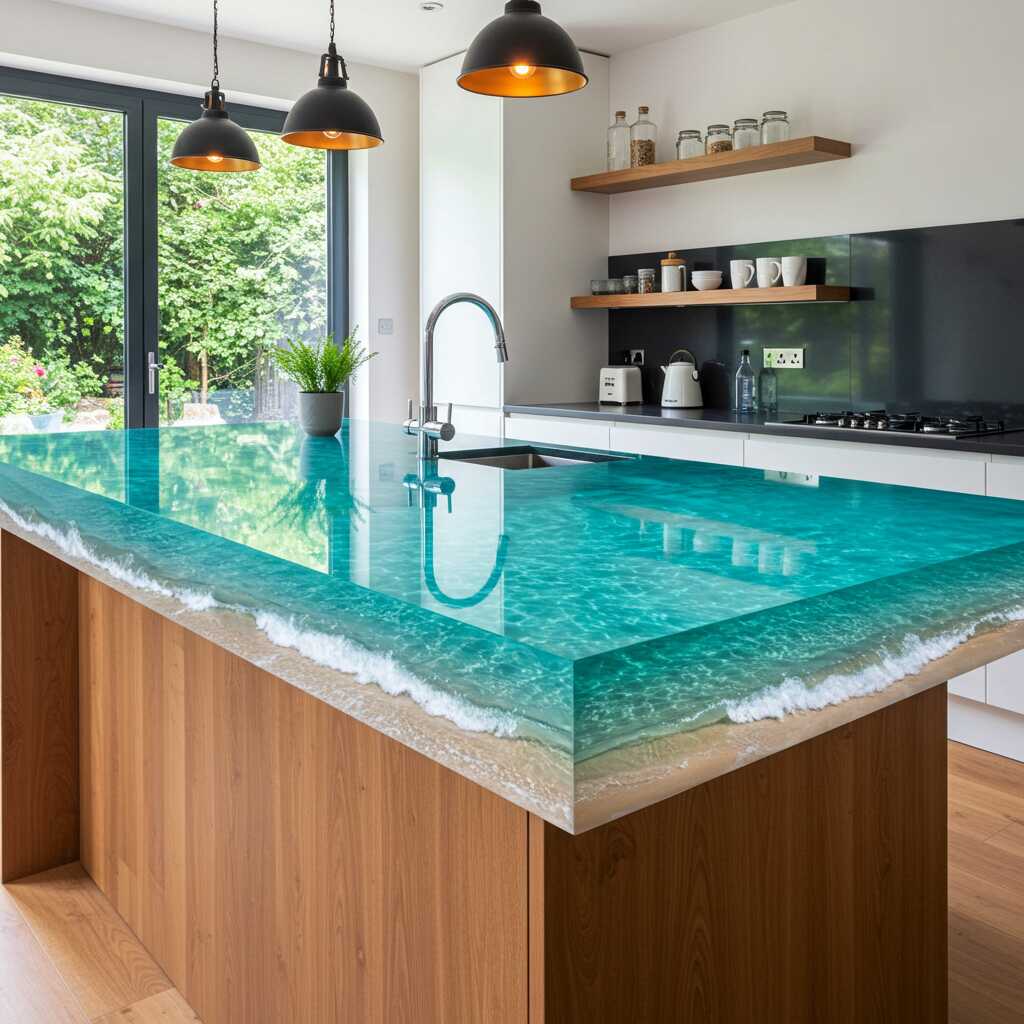The Allure of an Epoxy Beach Countertop
In the ever-evolving world of interior design, homeowners are constantly seeking innovative ways to breathe new life into their living spaces. Among the most transformative trends is the use of epoxy resin countertops, particularly those inspired by serene coastal aesthetics—aptly named “Epoxy Beach Countertops.” These stunning surfaces combine functionality and artistry, turning your kitchen into a breathtaking focal point that mirrors the tranquility of the ocean.
An epoxy beach countertop captures the essence of sandy shores, rolling waves, and sunlit horizons within its glossy finish. It’s not just a surface; it’s a statement piece that reflects personality, creativity, and a love for nature’s beauty. Whether you live near the coast or simply dream of bringing a touch of seaside charm into your home, this unique design option offers endless possibilities for customization while maintaining durability and practicality.
This article will explore why an epoxy beach countertop could be the perfect addition to your kitchen. From understanding what makes these countertops so special to learning how they can elevate your space, we’ll delve deep into every aspect of this trend. By the end, you’ll have all the information you need to decide if an epoxy beach countertop is right for you—and how to make it happen.
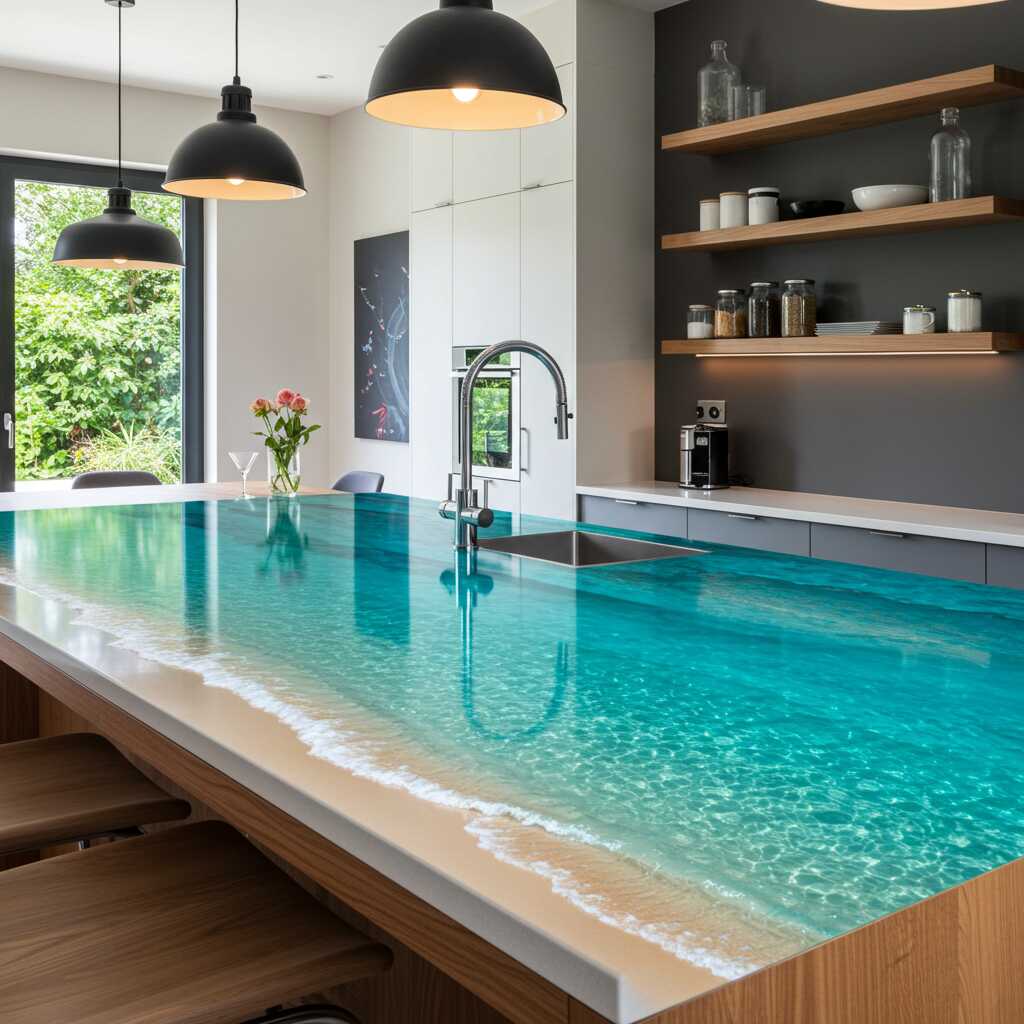
What Is an Epoxy Beach Countertop?
Defining the Magic Behind the Material
At its core, an epoxy beach countertop is crafted using a combination of epoxy resin and pigments designed to mimic natural elements like sand, water, and shells. The result is a seamless, glass-like surface that appears as though a slice of the beach has been frozen in time. Unlike traditional stone or laminate countertops, which often come in standard patterns and colors, epoxy allows for complete creative freedom. Each countertop becomes a one-of-a-kind masterpiece, tailored specifically to suit your vision.
The process involves layering different materials and techniques to create depth and texture. For instance, real sand can be embedded at the base to evoke the feel of a shoreline, while translucent blues and greens swirl together to replicate ocean waves. Some designs even incorporate seashells, sea glass, or metallic flakes to enhance the coastal theme. Once cured, the epoxy forms a hard, non-porous surface that resists scratches, stains, and heat—a feature that sets it apart from many other decorative options.
Why Choose Epoxy Over Other Materials?
While granite, marble, and quartz remain popular choices for kitchen countertops, epoxy presents several advantages that make it stand out:
- Customization: With epoxy, there are no limits to color schemes, textures, or patterns. You can achieve virtually any look you desire, making it ideal for achieving a personalized aesthetic.
- Cost-Effectiveness: Compared to high-end stones like marble or quartz, epoxy is significantly more affordable without compromising on appearance or quality.
- Durability: When properly installed, epoxy countertops are incredibly resilient. They’re resistant to moisture, chemicals, and everyday wear and tear, ensuring longevity.
- Low Maintenance: Thanks to their smooth, non-porous finish, epoxy countertops require minimal upkeep. A quick wipe-down with a damp cloth is usually sufficient to keep them looking pristine.
- Environmental Impact: Using recycled materials such as crushed glass or locally sourced sand adds an eco-friendly dimension to your project.
By choosing an epoxy beach countertop, you’re investing in both form and function—a decision that pays dividends in terms of style and practicality.
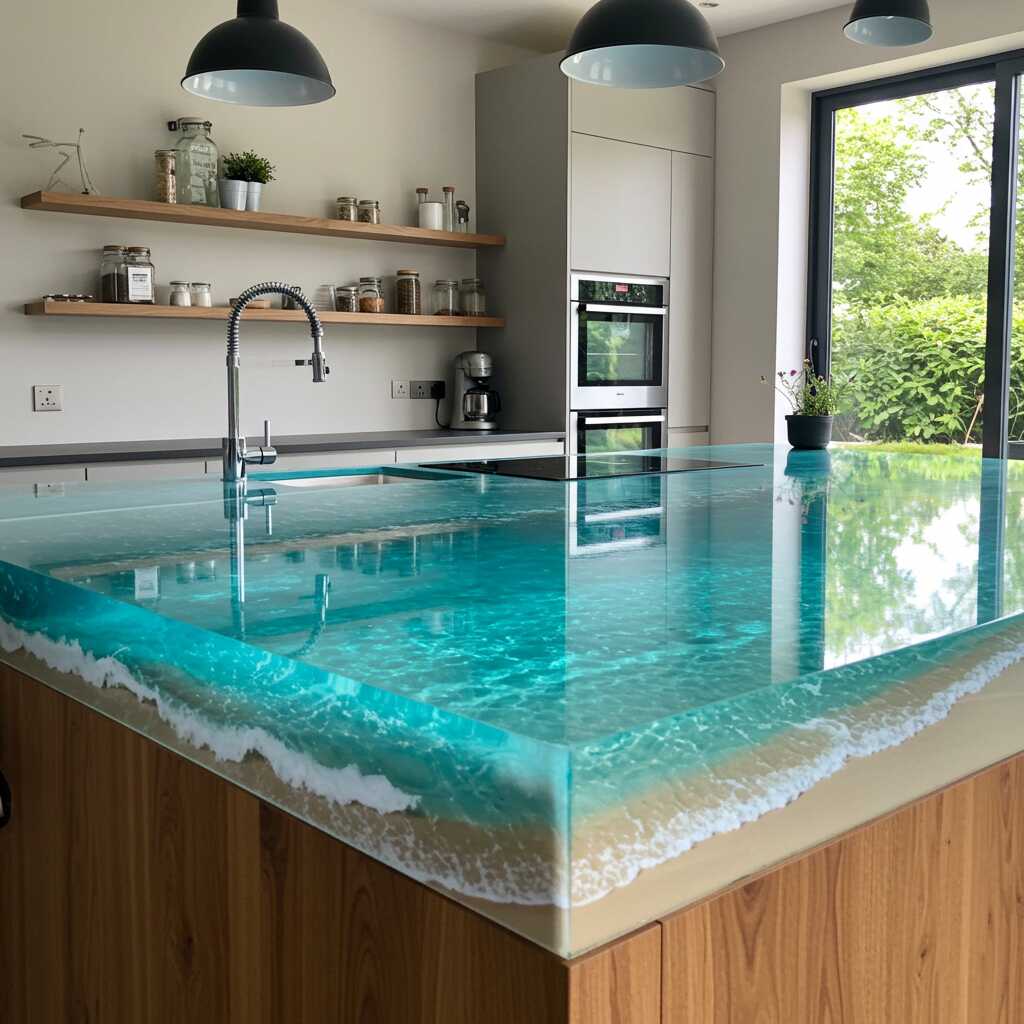
How to Create the Perfect Epoxy Beach Countertop
Step 1: Planning Your Design
Before diving into the installation process, take some time to envision your ideal countertop. Consider factors such as color palette, level of detail, and overall vibe. Do you want a minimalist design with subtle hints of the beach, or do you prefer something bold and vibrant that commands attention?
To gather inspiration, browse online galleries, Pinterest boards, or Instagram hashtags dedicated to epoxy countertops. Pay close attention to details like wave patterns, gradient transitions, and accent pieces (e.g., shells or starfish). Sketch out rough ideas or create a mood board to share with your contractor or DIY team.
Step 2: Preparing the Surface
Proper preparation is key to ensuring a flawless outcome. Start by cleaning the existing countertop thoroughly to remove grease, dirt, or debris. If necessary, sand down uneven areas to create a smooth foundation. Next, apply a primer coat to promote adhesion between the substrate and the epoxy layers.
For added authenticity, consider embedding actual sand along the edges or recessed sections of the countertop. This technique creates a tactile connection to the beach theme and enhances visual interest.
Step 3: Mixing and Pouring the Epoxy
Mixing epoxy requires precision and patience. Follow the manufacturer’s instructions carefully to achieve the correct ratio of resin to hardener. Add pigments gradually, experimenting with shades until you achieve the desired effect. To recreate the appearance of ocean waves, pour multiple colors side by side and use tools like brushes, blowtorches, or silicone spatulas to blend them organically.
Once poured, allow the epoxy to self-level before moving on to decorative elements. This stage is where you can get creative—scatter small seashells, embed glittery accents, or sprinkle fine grains of sand for extra texture. Work quickly but methodically, as epoxy begins to cure after a certain period.
Step 4: Curing and Finishing Touches
After pouring, let the epoxy cure undisturbed for at least 24-48 hours, depending on environmental conditions. During this time, avoid touching or disturbing the surface to prevent imperfections. Once fully hardened, inspect the countertop for air bubbles or uneven spots. Use a heat gun or lighter to pop any remaining bubbles, then lightly sand the surface for a polished finish.
Finally, seal the countertop with a protective topcoat to enhance shine and durability. This step ensures your epoxy beach countertop remains resistant to daily wear and tear for years to come.
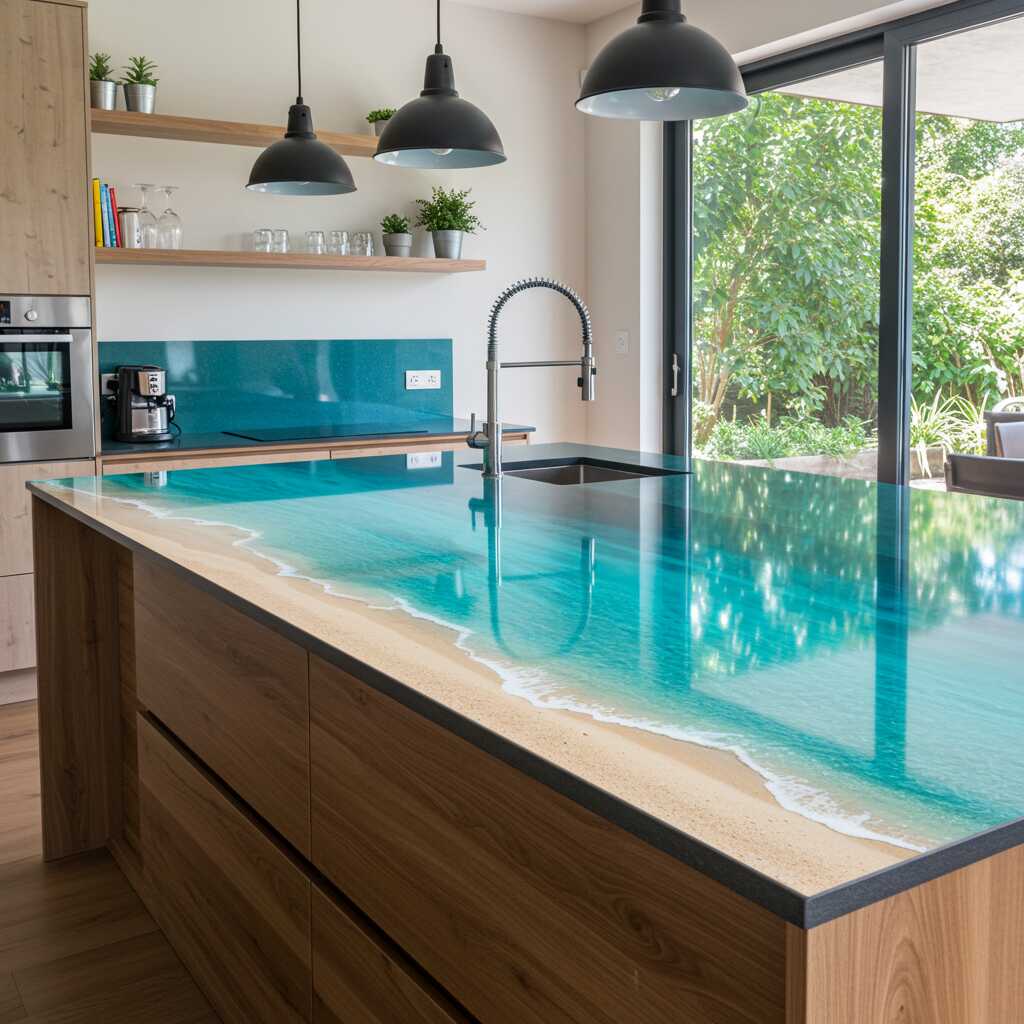
Benefits of Installing an Epoxy Beach Countertop
Aesthetic Appeal
One of the primary reasons homeowners opt for an epoxy beach countertop is its unparalleled aesthetic appeal. Few materials can rival the ability of epoxy to capture intricate details and vivid imagery. Imagine walking into your kitchen each morning and being greeted by the calming hues of turquoise waters or the golden glow of sunset-lit sands. Such visuals not only brighten up your space but also evoke positive emotions and relaxation.
Increased Property Value
Beyond personal enjoyment, installing an epoxy beach countertop can boost your property’s market value. Potential buyers are often drawn to homes with standout features that reflect modern trends and craftsmanship. A well-executed epoxy countertop signals attention to detail and a willingness to invest in high-quality upgrades—an attractive selling point for future transactions.
Versatility Across Styles
While inherently tied to coastal themes, epoxy beach countertops can adapt to various design styles. Pair them with shiplap walls and whitewashed cabinets for a classic beach house vibe, or contrast them against dark wood tones and industrial fixtures for a contemporary twist. Their versatility ensures compatibility with virtually any decor scheme.
Sustainability Considerations
For environmentally conscious individuals, epoxy countertops offer opportunities to incorporate sustainable practices. Opt for locally sourced materials, reuse old countertops as substrates, or choose eco-friendly pigments to minimize your carbon footprint. Additionally, the long lifespan of epoxy reduces waste associated with frequent replacements.
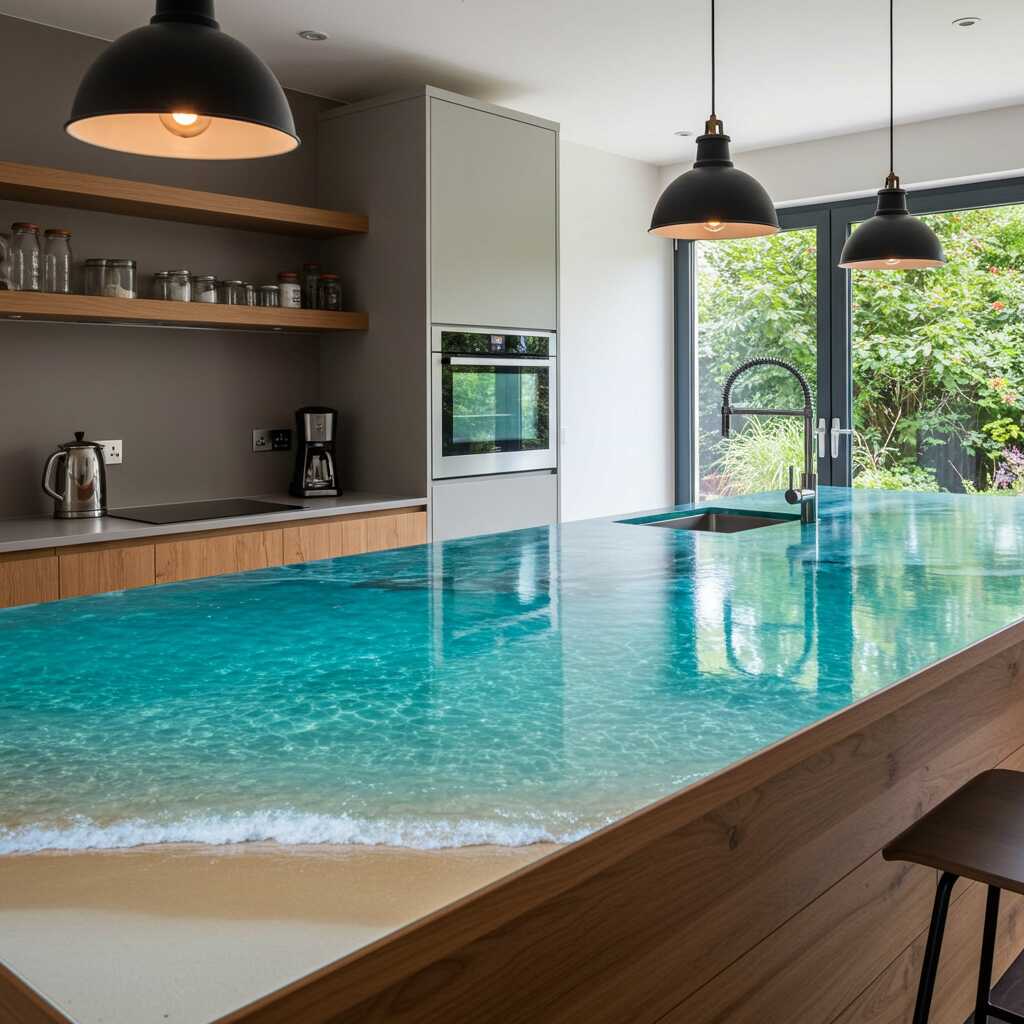
Common Concerns About Epoxy Beach Countertops
Despite their numerous benefits, some people hesitate to adopt epoxy countertops due to misconceptions or concerns. Let’s address a few common questions:
Is Epoxy Heat Resistant?
Yes, epoxy is highly heat-resistant when applied correctly. However, prolonged exposure to extreme temperatures (such as placing hot pots directly on the surface) may cause discoloration or damage. Always use trivets or mats to protect your countertop from direct heat sources.
Can Epoxy Be Repaired?
Minor chips or scratches can typically be repaired by sanding and reapplying a fresh layer of epoxy. More extensive damage might require professional intervention, but the repairability of epoxy makes it a reliable choice compared to brittle materials like ceramic tile.
Does Epoxy Yellow Over Time?
Modern epoxy formulations are UV-stable and less prone to yellowing than older versions. Still, prolonged sunlight exposure may affect certain pigments. To preserve vibrancy, consider applying a UV-resistant sealant or positioning your countertop away from direct sunlight.
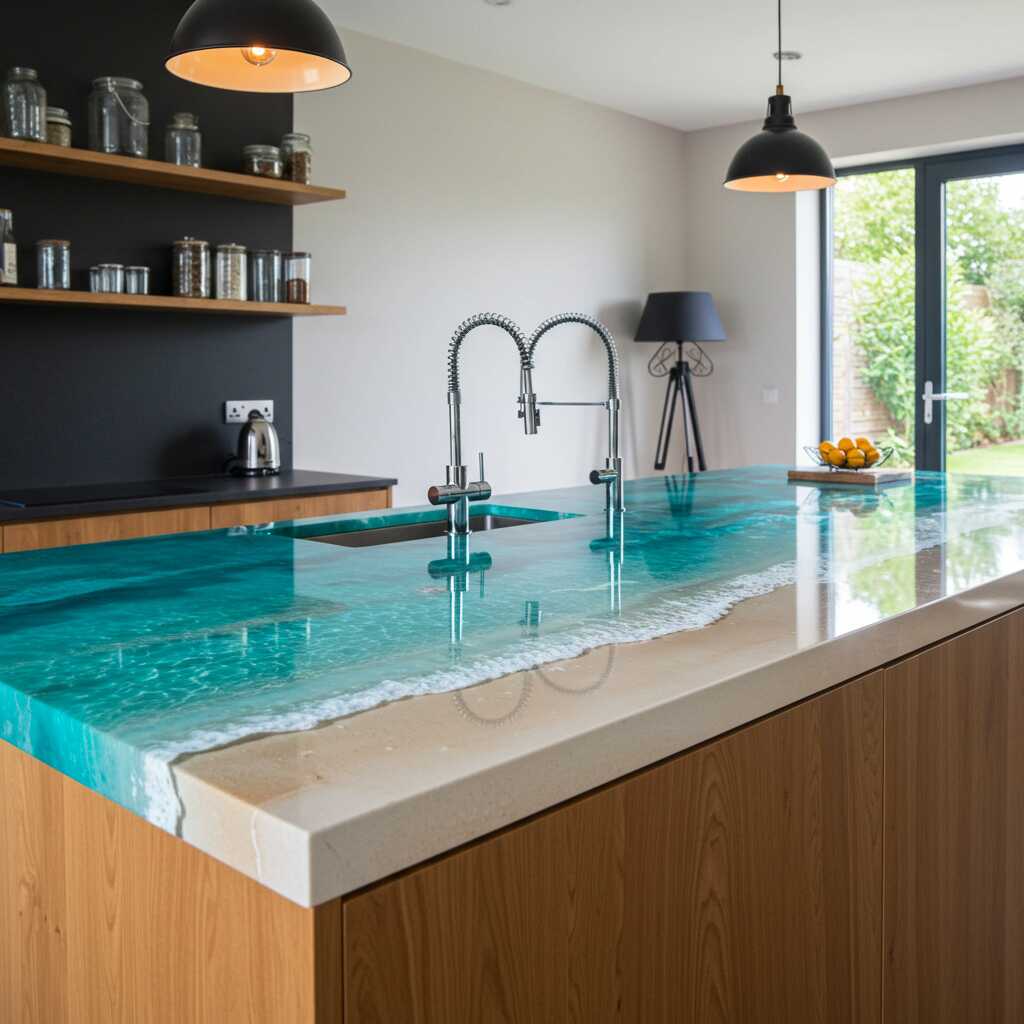
Conclusion: Embrace the Beauty of an Epoxy Beach Countertop
Transforming your kitchen with an epoxy beach countertop is more than just a renovation—it’s an opportunity to infuse your home with personality, elegance, and a sense of escape. From its customizable designs to its impressive durability, this innovative material checks all the boxes for modern homeowners seeking both style and substance.
Whether you’re captivated by the idea of recreating the serenity of the shore or eager to experiment with bold artistic expressions, an epoxy beach countertop promises to deliver unmatched results. With proper planning, execution, and care, you can enjoy a functional yet visually stunning centerpiece that stands the test of time.
